How to Buy an Engagement Ring if You Dont Know the Size
Colored gemstone engagement rings are hot. They're showing up on royalty and celebrities alike. They're beautiful. They're unusual. And they can be a smashing value. Here'due south what yous need to know when you go shopping.
In this blog, nosotros encompass:
- Why the trend in colored gemstone engagement rings
- What'southward great nearly colored gemstone engagement rings
- Durability and colored gemstone engagement rings
- Other qualities to expect for in colored gemstone engagement rings
- Caring for colored gemstone engagement rings
- Setting styles for colored gemstone date rings
- How to buy colored gemstone engagement rings
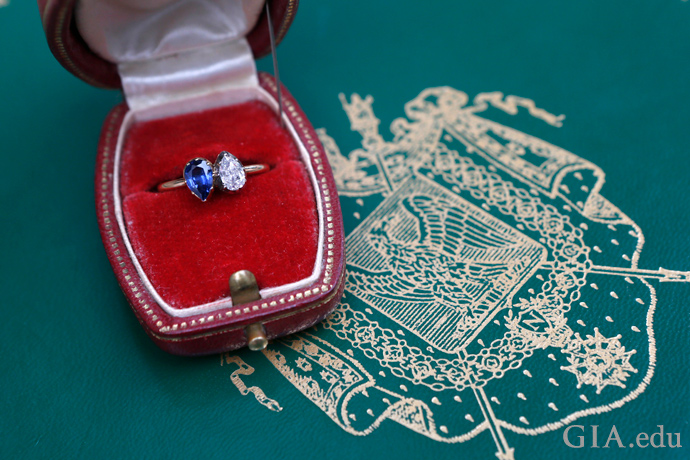
The Empress Josephine toi et moi ("you and me") date ring features a 1 carat (ct) pear shaped sapphire and diamond mounted in 18K gold. Photo: PATRICK KOVARIK. Courtesy: AFP/Getty Images
Why the trend in colored gemstone date rings
Colorful gemstone engagement rings are decorating the fingers of royals and other style makers, reviving a not-so-new trend for adding pops of colour – and personality – to traditional colorless diamond engagement rings.
Some stylistas are achieving the colour-me look with pink, yellow or blue diamonds, while others turn to the world of colored gemstones to observe their splash of colour.
More than 200 years ago, in 1796, Napoleon Bonaparte gave his future empress, Joséphine, a sapphire and diamond toi et moi ("you and me") ring for their appointment.
Today, Kate Middleton, the Duchess of Cambridge, wears what is probably the most famous colored gemstone appointment ring. A cute cosmos that one time belonged to Princess Diana, it boasts a 12 ct sapphire encircled by diamonds.
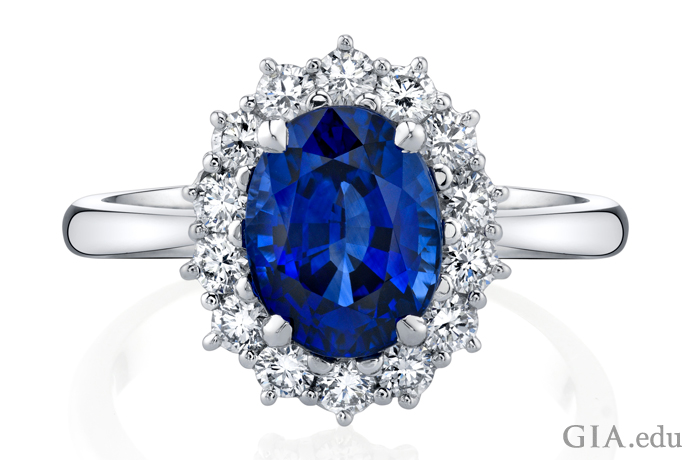
If you like Kate Middleton's appointment band, then you're certain to beloved this beauty. A 2.73 ct oval sapphire glows the brighter for being accented by 0.56 carats of diamonds. Courtesy: Omi Privé
Kate's recently engaged cousin past marriage, Princess Eugenie, girl of Prince Andrew and Sarah Ferguson, opted for a slightly orangy pinkish padparadscha sapphire, surrounded by round brilliant cut diamonds. The style somewhat resembles the engagement ring her female parent (the Duchess of York) received – a cherry-red with a halo of diamonds.
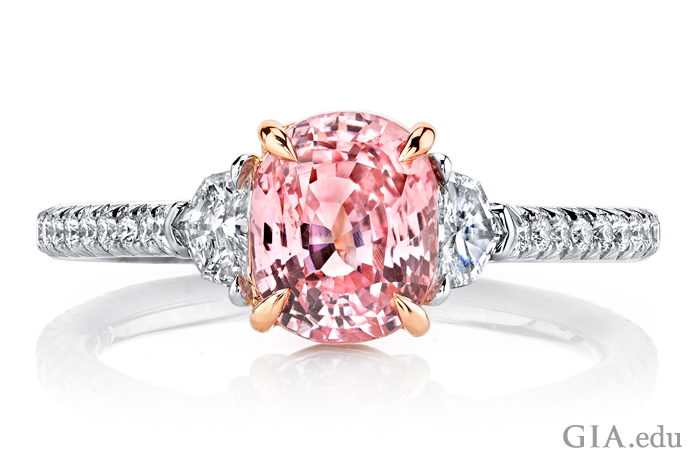
Like Princess Eugenie's appointment ring, this 2.02 ct padparadscha sapphire and diamond ring is both beautiful and unusual. Courtesy: Omi Privé
In the celebrity world, extra Jenny McCarthy wears a 10 ct xanthous sapphire engagement ring framed by diamonds. Ashlee Simpson'due south vintage-style ring features a marquise diamond surrounded by calibré cut rubies. Elizabeth Hurley sports a 9 ct bluish sapphire framed by two trilliant cutting diamonds in a archetype blueprint.
For these trendsetters – and many other brides – incorporating colored gemstones into an date ring offers myriad options to display their individual manner and personality. Information technology'south a look that's both timeless and gimmicky.
What'due south peachy about colored gemstone date rings
At that place's a lot to love about colored gemstone date rings. First, there's the obvious: color. Explore the globe of colored gems and you'll find a rainbow, from the deep reds of reddish and blues of sapphire, to the grassy greens of tsavorite garnet and kaleidoscopic colors of spinel. In that location's a precious stone for every hue imaginable.
2d, with colored gemstones you lot tin can add more depth of meaning to the appointment band. For example, you could include your birthstone and your partner'due south birthstone, alone or with diamonds. Colored gemstones also come with historic symbolism, and you could pick 1 that inspires you. Have sapphire – it has traditionally been associated with sincerity, truth and faithfulness.
Yous tin can too utilise colored gemstones to send secret messages. The Victorians turned this into an art grade with acrostic jewelry – using the showtime letter of each gemstone to spell a give-and-take. For example, a diamond, eastmerald, amethyst and ruby set together would spell the discussion "dear." Acrostic jewelry can also exist designed to spell birthdays, private messages or a clandestine shared between yous and your beloved.
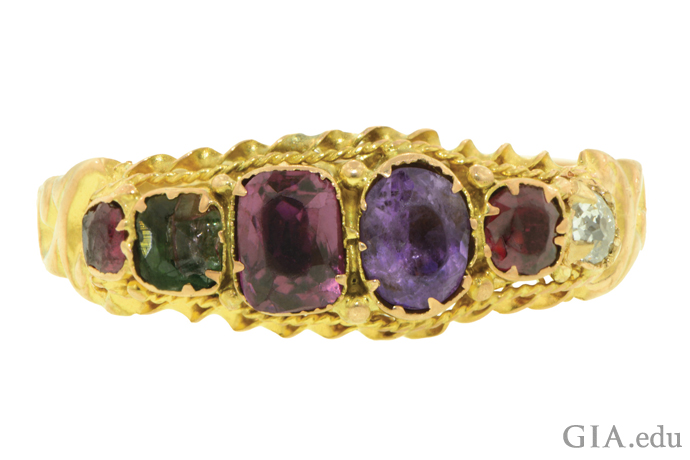
This acrostic ring was fabricated in England during the Victorian era (1837–1901). The gems spell "regard" from left to correct: ruby, eastmerald, karnet, amethyst, ruby and diamond. Courtesy: Doyle & Doyle
Finally, there's affordability. Colored gemstones are a great way to add together size to an engagement band. This is especially true if yous look beyond rubies and sapphires toward gems that are less well known only every bit equally beautiful – and ordinarily significantly less expensive. Examples include the pinkish beryl morganite, the many colors of spinel and tourmaline, or intense dark-green, red or orange garnets.
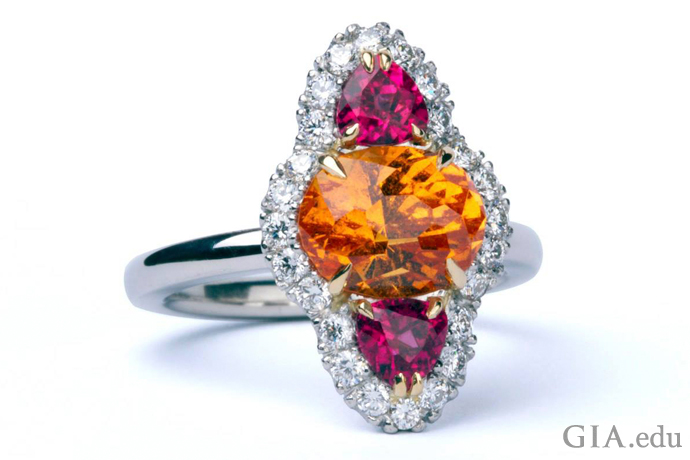
If your helpmate-to-exist's favorite colors are orange and pink, this ring featuring a spessartine garnet eye rock cut by John Dyer, pink tourmaline side stones and diamond melee is sure to please. Courtesy: John Dyer & Co.

The color of morganite can be very similar to that of a pink diamond, but this seven.07 ct morganite is a striking – and more affordable – option. Courtesy: 1stdibs.com
Morganite engagement rings are recent favorites with brides-to-be – and for proficient reason. Pink has traditionally been the color of romance, and morganite ranges from pastel pink to purplish, yellow or orangy pinkish. Similar hues are seen in pink diamonds, but you lot can accept a large, attractive morganite for a small fraction of their cost.
Blue zircon, with its loftier dispersion, is ofttimes mistaken for blueish diamonds. Yet while the cost of fifty-fifty a ane ct bluish diamond would be prohibitive for most buyers, a 3 or 4 ct blueish zircon appointment band is obtainable for far less than an boilerplate month'south salary.
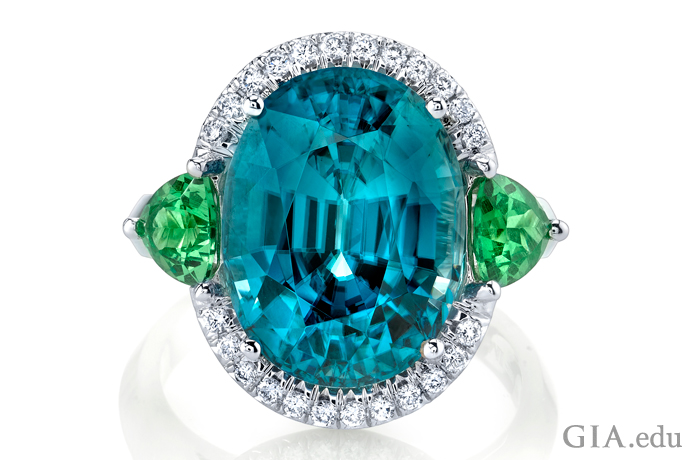
Find beauty in blue with this 6.74 ct cushion cut zircon ring accented with trilliant cut tsavorite garnet side stones and round bright cut diamonds set in 18K white gold. Courtesy: Omi Privé
Spinel and tourmaline are ii other gems that offer a wide range of color options and great value. They occur in colors that are very similar to those of fine crimson or sapphire, but a top-quality 5 ct red tourmaline (rubellite) could be purchased for less than a third of the cost of a comparable 2 ct carmine – delivering more bling for your buck.
1 of the nigh heady, if less well known, colored gemstones seen in engagement rings is the green garnet known as tsavorite. More durable and often brighter than emerald, whose color it mimics, a fine tsavorite garnet is ordinarily less expensive than its counterpart.

An alternative and more durable option than emerald, this 2.86 ct tsavorite ring with diamond accents stands out from the crowd. Photo: Emily Lane/GIA. Courtesy: Sara and Bret Keller
With so many different colored gemstones available, your claiming will be finding one that sets your centre aflame – and making sure the gem is tough enough for daily wear.
Durability and colored gemstone engagement rings
Immovability is a major consideration when searching for an engagement band gemstone. The gem you choose must withstand the bumps and bangs of daily wearable, plus the effects of heat, light, household chemicals and low or high humidity. Different gemstones have different backdrop and, as a result, different tolerances to these stressors.
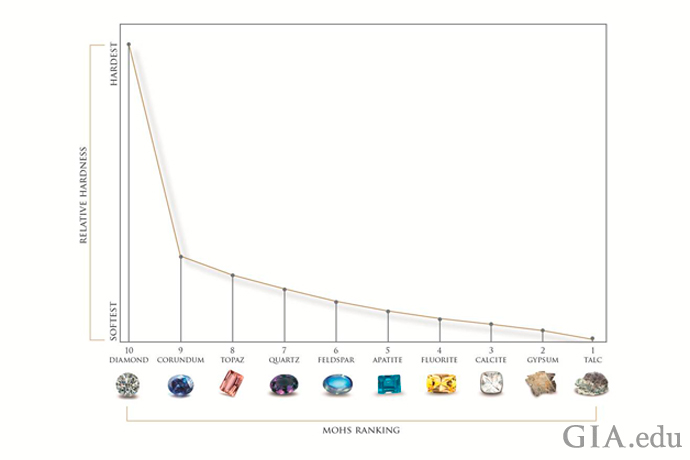
Introduced in the early on 19th century, the Mohs scale ranks precious stone and mineral hardness in a range from ane (least hard – talc) to 10 (hardest of all – diamond). Illustration: GIA
One aspect of gemstone immovability is hardness. The Mohs calibration ranks gem and mineral hardness on a calibration of 1 (least hard – talc) to 10 (hardest of all – diamond). Ruby and sapphire rank 9, significant they are able to resist scratching and abrasions. This makes them groovy choices for date rings that volition come across a lifetime of agile wearable. Although less hard, spinel (eight), morganite (seven.5–8), zircon (7.5), and tsavorite garnet and tourmaline (both vii–vii.v) are considered durable enough for everyday article of clothing provided care is exercised (no stone climbing!).
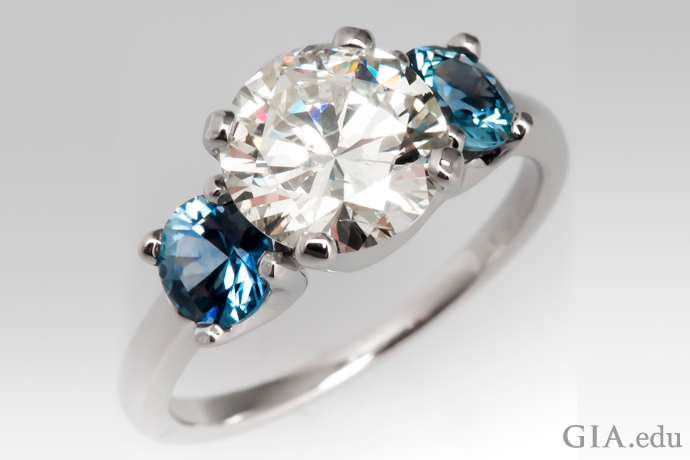
Ii Montana sapphires weighing a full of 1.19 carats bookend a 2.05 ct circular brilliant diamond. Courtesy: EraGem.com
Toughness and stability are two additional factors that determine a gemstone's immovability.
Toughness indicates how well a gemstone resists breaking, chipping or cracking. The way the atoms of a gem bond together and the strength of these bonds determine gemstone toughness. Examples of not-so-tough gems are opal and tanzanite which, if set in rings, are best reserved for special occasions – not everyday wear.
Stability refers to how well a gemstone can withstand exposure to chemicals, light and changes in temperature or humidity. Extreme temperature changes tin harm some gems like opal and tanzanite. Opals can crack or craze in low humidity or with exposure to heat. Citrine, amethyst and topaz may fade or change color from prolonged exposure to sunlight. Light and/or oestrus tin also negatively bear upon well-nigh organic gems – such as pearls, coral and amber – as will exposure to household chemicals.

Tanzanite is a beautiful gem that calls for special occasions. At half-dozen to 7 on the Mohs scale with fair-to-poor toughness, it's not ideal for an date ring that will see a lifetime of daily clothing. Courtesy: Omi Privé
It's important to annotation that many colored gemstones are routinely treated to improve their color and/or clarity. Designed to bring out the inherent dazzler of a gem, many of these treatments are widely accepted in the gem trade. However, you lot should be aware that some treatments tin also touch on stability. Every bit a consequence, your gem may require special care.
For example, treatments such as blanket and fracture filling can be removed by heat and strong chemicals. Although emerald ranks 7.5–8 on the Mohs scale, it is not a tough jewel and is frequently treated with oil and/or resin to better clarity. This treatment also disguises fractures in the stone that tin can crusade information technology to pause if banged confronting a hard surface. If you accept your eye assail a greenish gemstone engagement ring you lot programme to wear every 24-hour interval, you might want to consider a more than durable tsavorite garnet instead, reserving emeralds for earrings or pendants. Garnets are rarely treated and have good toughness.
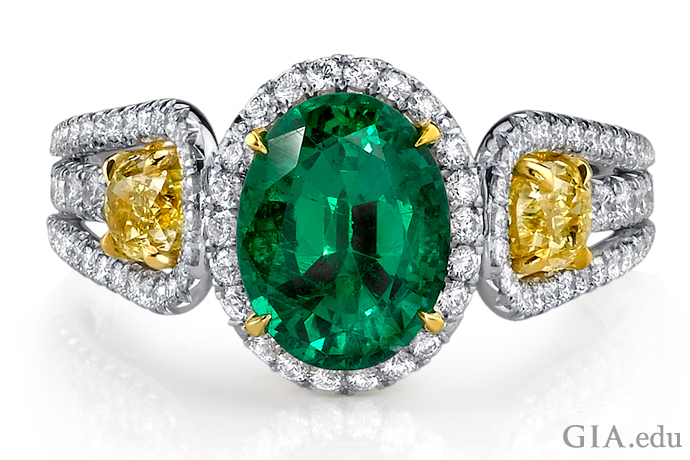
A halo of diamonds creates dissimilarity with the emerald and helps protect this popular but delicate stone. Two yellow diamonds add more than color and drama to the ring. Courtesy: Omi Privé.
Other qualities to look for in colored gemstone engagement rings
Color is king
Like colorless diamonds, the quality of a colored gemstone is determined past a combination of the 4Cs: color, clarity, cut and carat weight. For colored gems, however, color is past far the most important cistron. In some cases, such as whether a precious stone is called pink sapphire or cherry-red, or greenish beryl or emerald, the distinction may be made based on color alone. Clarity is important, but for most colored gems there is no universal grading system or set of standards to evaluate clarity. And cut may vary greatly from rock to stone. The goal is typically to maximize size and colour – or, every bit in the case of fantasy cuts, to create a work of art.
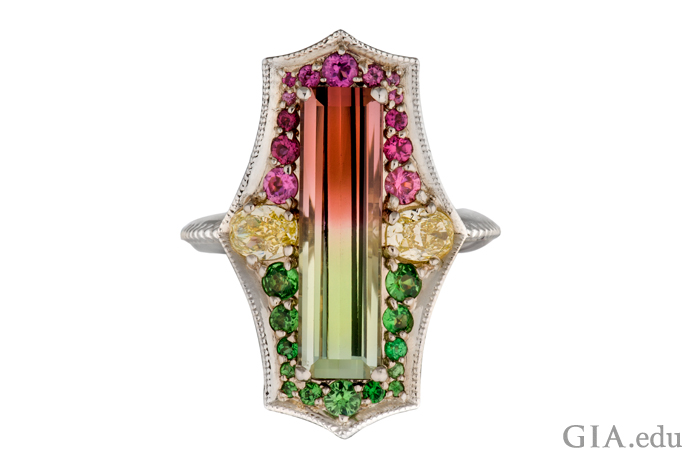
A slice of art to stand the examination of time, this 9.05 ct bi-colored tourmaline ring set in 14K white gilt features yellow diamonds, tsavorites and rubellites. Photograph: Orasa Weldon/GIA. Gift of Derek Katzenbach. In Retentivity of Nicholas Scott Aureate, University of Maine geology student.
There are, notwithstanding, some of import considerations to look for when assessing the quality of a colored gemstone in addition to the durability factors discussed above. Many gems prove more than one color. This can be an asset in a bi-colored tourmaline – for the bride-to-be who wants a truly unique colored stone engagement ring.
In other gems, such as blue sapphire, colorless zones seen on close inspection may backbite from the overall appearance of the jewel. And while high clarity is desirable in most colored gems, as it is in diamonds, a few identifying inclusions in an inconspicuous area (such as the culet) may ensure that the colored gem is natural (not synthetic) and untreated.
Optical phenomena
Colored gemstones also offer the possibility of certain phenomena, such as chatoyancy (the cat'due south-heart effect) and asterism (a star), that are non seen in diamonds. These phenomena are acquired by the reflection of light off dense inclusions of minerals in gems cutting every bit cabochons. Such phenomenal stones provide heady pattern options for a colored gemstone engagement band.

This 7.57 ct true cat's-centre chrysoberyl seems to symbolize ii lives united as i. Add a sparkling halo of circular brilliant cutting diamonds for strength and you take the perfect sentiment for an date ring. Photo: Robert Weldon/GIA. Courtesy: Richard Krementz Gemstones
Where the gem comes from
For some gems, such as ruby and sapphire, state of origin may besides play a pregnant function in determining value. For instance, a ruby from Myanmar ("Burmese" cherry) can cost significantly more than a comparable cherry from another locality, such as Mozambique. Similarly, there is a premium for sapphires from Kashmir, due to both their distinctive "cornflower blue" color and their rarity: There has not been major production from this region for more than than a century.
Who owned it before
Some other important cistron in determining price is historical provenance. An antique or vintage colored gemstone engagement ring may come up with its own story, and that story may have value. In i of the almost striking examples, when the Empress Josephine sapphire and diamond appointment ring mentioned above was offered at auction in 2013, the auction house estimated its value at $20,000 based largely on the gems alone. Ultimately, the winning bidder paid more than $1 million – a huge premium for the band's storied association with Napoleon Bonaparte and his first helpmate.
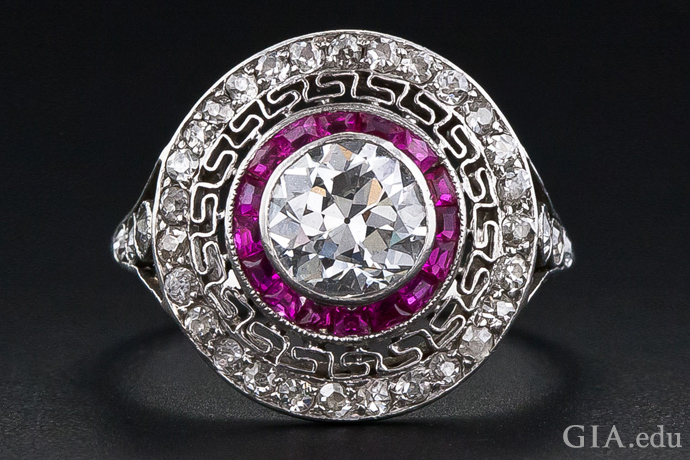
A ring of Burmese rubies encircles an Old European cut diamond in this Art Deco–era ring. A Greek fundamental motif made of platinum circles the rubies, while some other ring of diamonds completes the blueprint. Courtesy: LangAntiques.com
Quality and rarity drive value
Like diamonds, colored gems of high quality are rare, and then buyers typically pay a premium for acme-quality colored stones. Once you've decided on a gemstone for your appointment ring, it pays to comparison shop to empathize its quality factors and how they affect value. You should also learn every bit much as y'all tin can about your gemstone of choice. GIA's Jewel Encyclopedia is a skilful place to start. It provides in-depth information for 29 of the most popular gems on the market. You'll also discover detailed buying guides for each gem describing the specific qualities to look for, the jewel's immovability, common treatments and more.
Caring for colored gemstone engagement rings
After you've purchased your colored gemstone engagement band, you'll want to proceed information technology like new. The correct way to clean it volition vary depending on the jewel material you've chosen and whether or not it'south been treated. Usually, gentle cleaning solutions specially formulated for delicate gems – or just warm, soapy water and a soft textile – are all you demand. If you're uncertain near the immovability of your precious stone, avoid using ultrasonic cleaners and off-the-shelf cleaning solutions.
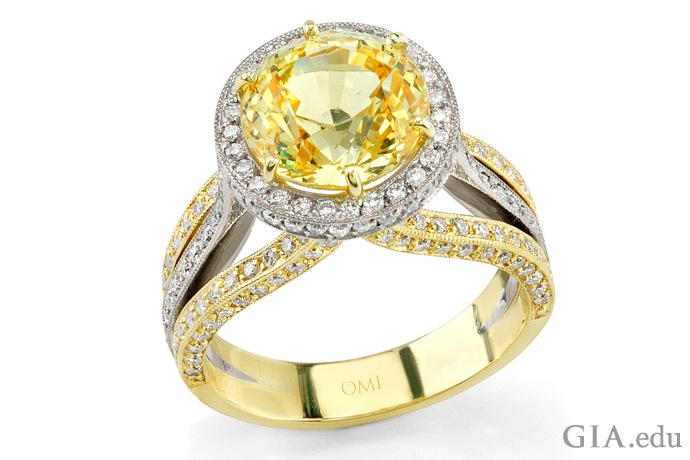
Washing with warm, soapy water is the safest mode to clean this 5.eleven ct yellow sapphire appointment ring, which is surrounded by 128 round diamonds weighing 0.75 carats. Courtesy: Omi Privé
Setting styles for colored gemstone engagement rings
Engagement band settings must secure the gems they hold besides as evidence them to their best advantage. Bezels, halos and other protective settings can play an of import role in preventing the chipping or great of colored gemstones. Merely who said applied tin't also be cute? Settings serve as an essential design element, defining an engagement ring's fashion and overall await. Settings allow you lot introduce contrasts in color or harmonize them to get just the right amount of colour pop in your ring. Consider these examples:
- A three-rock engagement ring. A three-stone engagement band is rich in symbolism: The gems represent yesterday, today and tomorrow. Wear it and yous'll proclaim that your dearest is eternal. The style has also withstood the test of time – three-rock diamond engagement rings engagement to at to the lowest degree the 17th century. Adding color with rubies, emeralds, sapphires and onyx to a white canvas of diamonds and platinum was popular in the Fine art Deco era.
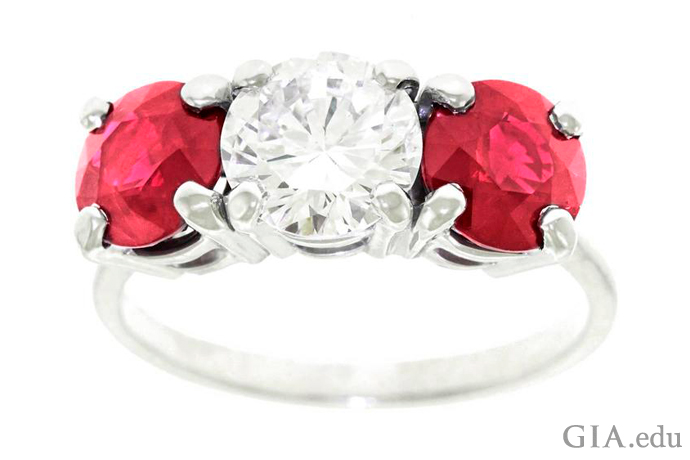
Create a fiery expect in an engagement ring by using this three-stone ring for inspiration. The two rubies (1.41 ct and 1.37 ct) bracketing the 1.39 ct circular brilliant diamond are sure to take hold of the eye. Courtesy: 1stdibs.com
- A halo setting. This setting features a circle of gems surrounding the center stone. Diamond date rings with halo settings have been specially popular these past several years because they're cute, add sparkle and brand the center stone look larger. The halo setting is likewise a favorite for colored gemstone engagement rings. You'll oft see the centre stone providing a bold splash of color, while a circle of diamonds or colored stones adds sparkle and contrast – as well as protection for the precious stone they environs.

Need more than proof that colored gemstones can bring excitement to an engagement ring? This stunning cosmos features a 2.57 ct spinel encircled by 0.20 carats of circular diamonds. Courtesy: Omi Privé
- A featherbed ring. Want an date ring that looks a bit unlike and has color? Consider the bypass ring – a style where the band overlaps, instead of completing the circumvolve. Bypass rings were popular in the Victorian era. The sentiment behind these toi et moi rings has an undeniably romantic cachet.

The diamond and sapphire in this Victorian-era bypass ring make for a delicate pairing. Courtesy: Treasurly by Dima
Jewelry designers are putting a contemporary stamp on three-stone, halo and bypass rings with colored gemstones. Their mod updates are a beautiful melding of past and nowadays – pieces that pop with color and life. Look around and you lot'll find a number of creative interpretations.
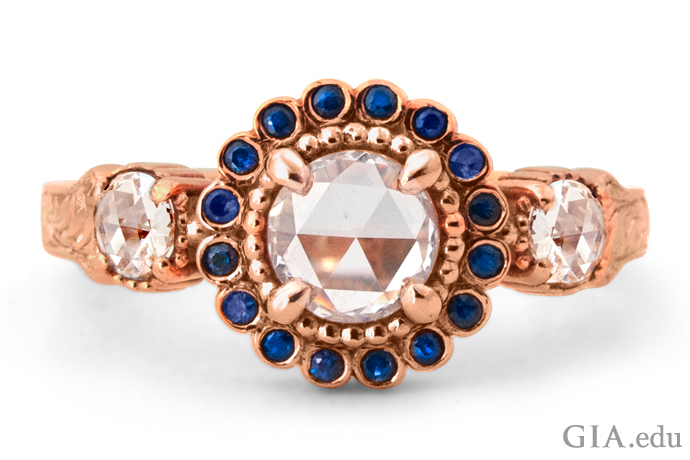
Something old. Something new. Something borrowed. Something blueish. Blue sapphires surround a rose cut diamond in this modern ring with a pattern borrowed from the Victorian era. Courtesy: Shelly Purdy Studio
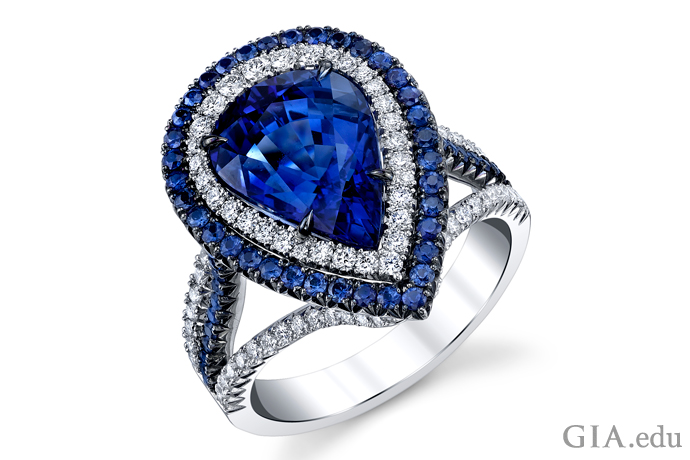
A pear shaped sapphire is surrounded past colorless diamonds and a second halo of sapphires. Diamonds and sapphires spill down the shank of the ring. The bold contrasting colors create a visual richness certain to please. Courtesy: Omi Privé
How to buy colored gemstone engagement rings
Now that you know about colored gemstone date rings, you're ready to starting time shopping. Merely where? The GIA Retailer Wait Up lets y'all easily find local retailers who take GIA-trained staff to help y'all through your gemstone selection process.
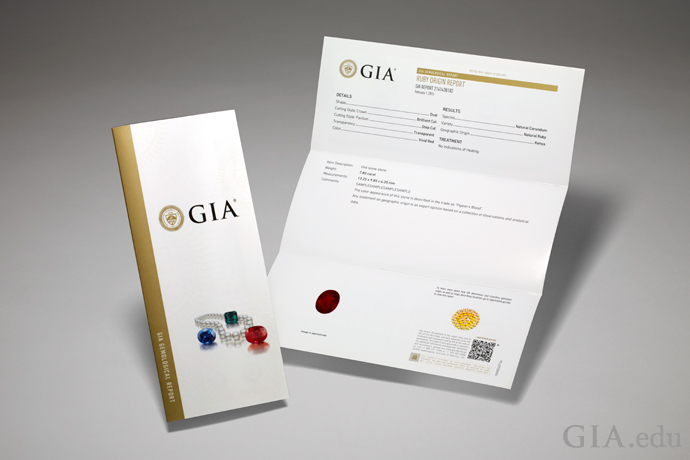
Before y'all determine on a colored gemstone engagement band, ask for a GIA Colored Stone Identification Written report.
To brand sure you go the best value, ask for an unbiased GIA Colored Rock Identification Study. The report volition validate the precious stone's identity and include detailed descriptions of its size, color and measurements, along with a color photo. The report will likewise indicate whether the gem has been treated and, if it has, identify the type of treatment – important to knowing how to intendance for your gem. Depending on the gemstone, you may also be able to get information on its geographic origin.
Need more inspiration for colorful appointment rings? Read our commodity on how to buy antique and vintage date rings for some exciting examples.
sanchezbefictopeaut.blogspot.com
Source: https://4cs.gia.edu/en-us/blog/colored-gemstone-engagement-rings-buying-guide/
0 Response to "How to Buy an Engagement Ring if You Dont Know the Size"
ارسال یک نظر